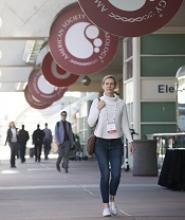SAN DIEGO—An interim analysis from the MAIA trial showed that adding daratumumab to lenalidomide and dexamethasone could significantly improve progression-free survival (PFS) in older patients with multiple myeloma (MM) who were ineligible for transplant.
The 30-month PFS rate was 71% in patients who received daratumumab plus lenalidomide and dexamethasone (DRd) and 56% in patients who received only lenalidomide and dexamethasone (Rd).
“These results support DRd as a new standard of care for elderly patients with myeloma who are ineligible for transplant,” said Thierry Facon, MD, of Hôpital Claude Huriez and the University of Lille in France.
Dr. Facon presented results from MAIA during the late-breaking abstracts session at the 2018 ASH Annual Meeting (abstract LBA-2).
The phase 3 trial (NCT02252172) enrolled 737 transplant-ineligible patients with newly diagnosed MM.
The patients were randomly assigned to DRd or Rd. Daratumumab was given at 16 mg/kg weekly for cycles 1 and 2, every other week for cycles 3 through 6, and every 4 weeks from cycle 7 until disease progression.
Lenalidomide was given at 25 mg orally per day on days 1-21 until disease progression, and dexamethasone was given at 40 mg orally or intravenously weekly until disease progression.
The median patient age was 73 years, and 99% of all patients were 65 or older. Demographic and clinical characteristics were well balanced between the treatment arms.
Results
The primary endpoint of PFS was superior with DRd.
At a median follow-up of 28 months, the median PFS had not been reached in the DRd arm and was 31.9 months in the Rd arm.
The 30-month PFS rate was 71% in the DRd arm and 56% in the Rd arm (hazard ratio [HR]=0.56; P<0.0001).
DRd was associated with a significantly higher overall response rate than Rd—93% and 81%, respectively (P<0.0001).
The complete response rates were 48% and 25%, respectively (P<0.0001). The rates of very good partial response or better were 79% and 53%, respectively (P<0.0001). And the rates of minimal residual disease negativity were 24% and 7%, respectively (P<0.0001).
DRd was associated with infusion-related reactions in 41% of patients, and 3% were grade 3 or 4 in severity.
Hematologic treatment-emergent adverse events of grade 3 or higher that were more common with DRd than Rd included neutropenia (50% vs. 35%) and lymphopenia (15% vs. 11%).
Conversely, grade 3/4 thrombocytopenia (7% vs. 9%) and anemia (12% vs. 20%) were more frequent with Rd.
Nonhematologic treatment-emergent adverse events that were more frequent with DRd included diarrhea, constipation, fatigue, peripheral edema, and pneumonia.
Rates of asthenia, back pain, nausea, and deep vein thrombosis/pulmonary embolism were similar between the treatment arms.
Janssen funded this study. Dr. Facon reported relationships with Celgene, Janssen, Takeda, Sanofi, Amgen, Karyopharm, and Oncopeptides.


